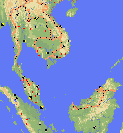 Range of Dacrydium elatum (1). Adapted from a map by www.expediamaps.com | Dacrydium elatum (Roxb.) Wallich ex Hook. 1843Common Names"Ru, M; Borneo: ouk, Kayan, sempilor, Merurong Plateau" (1).Taxonomic notesSyn: Juniperus elata Roxb. 1832; D. junghuhnii Miq. 1851; D. pierrei Hickel 1930; D. beccarii var. subelatum Corner 1939 (1).Description"Large tree, 8-40 m high, 0.1-1 m diam., with many slender, more or less erect branches and crowds of branchlets forming tufts which together construct a great billowy dome. Juvenile leaves linear-lanceolate, pungent, spreading but curved forward parallel to the branch, keeled on four sides, to at least 14 mm long, 0.3 mm wide and 0.2 mm thick, gradually becoming shorter and slightly broader with the leaves at the bases of ultimate shoots and on more vigorous shoots noticeably smaller and less spreading. Transitional forms which are sometimes fertile have spreading leaves slightly bent forward towards the acute tip, triangular in cross section, 0.3-0.4 mm wide, 0.2 mm thick, and 2-4 mm long, the leaves on vigorous shoots more nearly scale-like. Adult foliage shoots cord-like, 1-2 mm diam., leaves in the form of imbricate triangular scales 1-1.5 by 0.4-0.6 mm, sharply keeled on their exposed surface. Juvenile shoots sometimes mix with adult shoots thus giving a false impression that leaves change abruptly as the tree matures. The fertile structures are terminal. Pollen cones small, 4-5 mm long and 1-1.2 mm in diam. Apex of microsporophyll 0.5-0.8 mm long. The seed-bearing structure, even when produced on needle-bearing branches, is subtended by a scaly peduncle several mm long with scales about 1 mm long. The seed cone consists of about a dozen slightly elongated bracts 1.5-2 mm long. The solitary seed is 4-4.5 mm long" (1).RangeIndochina; Thailand; Malaya (very common, incl. Penang I.); Sumatra (only local in Westcoast Res., Batak Lands); Borneo (Sarawak & Sabah, rather rare) (1)."Scattered in moist rain-forest, from sea-level but mostly above several hundred m to 1,700 m, growing most abundantly in open situations indicating a preference for disturbed conditions. It also appears to prosper on difficult soils (sandstone, granite, kerangas). Hardy and popular under cultivation in fully exposed sites. Does not enter into high mountain scrub" (1). Big TreeOldestDendrochronologyEthnobotanyObservationsRemarksListed (as D. pierrei) as threatened in Viet Nam by the World Conservation Monitoring Centre."Dacrydium beccarii var. subelatum was established for trees bearing the intermediate foliage, a condition which appears to be persistent on certain individuals, some of them growing on high mossy ridges. Actually fruiting specimens with intermediate foliage occur sporadically throughout the range of D. elatum (de Laubenfels, Blumea 23, 1976, 97). Corner thought that this variety was somehow transitional, even suggesting that D. beccarii – of which he made it a part – might be a hybrid between D. comosum and D. elatum. Indeed, the individuals on high mossy ridges may well be hybrids between D. beccarii and D. elatum as they seem always to occur where the ranges of these two species approach one another. In any case, all such plants can be distinguished by much shorter leaves on vigorous shoots than for D. beccarii and generally variable leaf size" (1). Citations(1) de Laubenfels 1988.See also Dallimore & Jackson 1967 and Silba 1986. |
[Dacrydium] [Podocarpaceae] [home] This page is from the Gymnosperm Database |